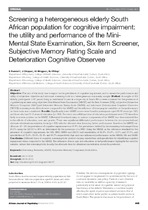| dc.contributor.author | Ramlall, Suvira | |
| dc.contributor.author | Chipps, Jennifer | |
| dc.contributor.author | Pillay, Basil | |
| dc.contributor.author | Bhigjee, Ahmed | |
| dc.date.accessioned | 2014-10-23T13:08:44Z | |
| dc.date.available | 2014-10-23T13:08:44Z | |
| dc.date.issued | 2013 | |
| dc.identifier.citation | Ramlall, S., et al. (2013). Screening a heterogeneous elderly South African population for cognitive impairment: the utility and performance of the Mini-Mental State Examination, Six Item Screener, Subjective Memory Rating Scale and Deterioration Cognitive Observee. African Journal of Psychiatry, 16(6): 445-455 | en_US |
| dc.identifier.issn | 1994-8220 | |
| dc.identifier.uri | http://hdl.handle.net/10566/1271 | |
| dc.description.abstract | OBJECTIVE:
The aim of this study was to report on the prevalence of cognitive impairment, and to assess the performance and utility of subjective, objective and informant screening tools in a heterogeneous community sample.
METHOD:
A sample of 302 elderly participants (>60 years) living in residential homes in a large city in South Africa were screened for the presence of cognitive impairment using objective (Mini-Mental State Examination [MMSE] and Six Item Screener-[SIS]), subjective (Subjective Memory Complaint [SMC]and Subjective Memory Rating Scale [SMRS]) and informant (Deterioration Cognitive Observee [DECO]) screening tools. All tools were compared to the MMSE and the influence of demographic variables on the performance on these tools was considered.
RESULTS:
Significantly lower MMSE scores were found in participants aged 80-89 years (p=.023) and those who had 8-11 years of education (p=.002). For every one additional year of education, participants were 0.71 times less likely to screen positive on the MMSE. Differential item functioning on various components of the MMSE was demonstrated due to the effects of education, race and gender. There was significant differential performance between the recommended and alternate attention/concentration items (p<.001) with the alternate item favouring better performance. Based on the MMSE cutoff score of < 23, the prevalence of cognitive impairment was 16.9%; the prevalence yielded by the remaining tools ranged from 10.5% using the DECO to 46% as determined by the presence of a SMC. Using the MMSE as the reference standard for the presence of cognitive impairment, the SIS, SMC, SMRS and DECO had sensitivities of 82.3%, 54.6%, 17.0% and 37.5%, and specificities of 71.3%, 57.6%, 87.4% and 96.7% respectively. Age and race influenced performance on the MMSE, SIS and SMRS.
CONCLUSION:
Different types of cognitive screening tools yielded varying sensitivities and specificities for identifying cognitive impairment when compared to the MMSE. The influence of race, age and education on test performance highlights the need for suitable, culture-fair screening tools. Locally, the alternate item for attention/concentration should be preferred. | en_US |
| dc.language.iso | en | en_US |
| dc.publisher | OMICS Publishing Group | en_US |
| dc.rights | © 2013 Ramlall, et al; licensee OMICS Publishing Group. This is an Open Access article distributed under the terms of the Creative Commons Attribution License (http://creativecommons.org/licenses/by/3.0), which permits unrestricted use, distribution, and reproduction in any medium, provided the original work is properly cited. | |
| dc.source.uri | http://dx.doi.org/10.4314/ajpsy.v16i6.57 | |
| dc.subject | Screening | en_US |
| dc.subject | Dementia | en_US |
| dc.subject | South Africa | en_US |
| dc.title | Screening a heterogeneous elderly South African population for cognitive impairment: the utility and performance of the Mini-Mental State Examination, Six Item Screener, Subjective Memory Rating Scale and Deterioration Cognitive Observee | en_US |
| dc.type | Article | en_US |
| dc.privacy.showsubmitter | false | |
| dc.status.ispeerreviewed | true | |
| dc.description.accreditation | Web of Science | en_US |

